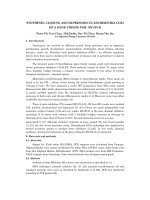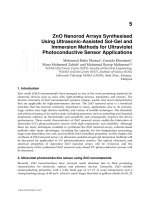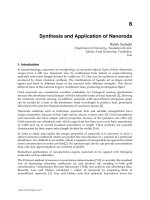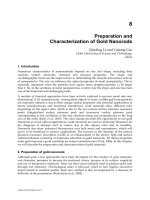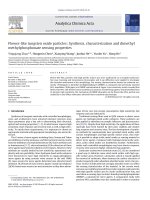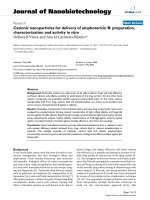Enhanced preferential cytotoxicity through surface modification: Synthesis, characterization and comparative in vitro evaluation of TritonX-100 modified and unmodified zinc oxide
Bạn đang xem bản rút gọn của tài liệu. Xem và tải ngay bản đầy đủ của tài liệu tại đây (2.01 MB, 10 trang )
KC et al. Chemistry Central Journal (2016) 10:16
DOI 10.1186/s13065-016-0162-3
RESEARCH ARTICLE
Open Access
Enhanced preferential cytotoxicity
through surface modification: synthesis,
characterization and comparative in vitro
evaluation of TritonX‑100 modified
and unmodified zinc oxide nanoparticles
in human breast cancer cell (MDA‑MB‑231)
Biplab KC1, Siddhi Nath Paudel1, Sagar Rayamajhi1, Deepak Karna1, Sandeep Adhikari1, Bhupal G. Shrestha1
and Gunjan Bisht2*
Abstract
Background: Nanoparticles (NPs) are receiving increasing interest in biomedical research owing to their comparable size with biomolecules, novel properties and easy surface engineering for targeted therapy, drug delivery and
selective treatment making them a better substituent against traditional therapeutic agents. ZnO NPs, despite other
applications, also show selective anticancer property which makes it good option over other metal oxide NPs. ZnO
NPs were synthesized by chemical precipitation technique, and then surface modified using Triton X-100. Comparative study of cytotoxicity of these modified and unmodified NPs on breast cancer cell line (MDA-MB-231) and normal
cell line (NIH 3T3) were carried out.
Results: ZnO NPsof average size 18.67 ± 2.2 nm and Triton-X modified ZnO NPs of size 13.45 ± 1.42 nm were synthesized and successful characterization of synthesized NPs was done by Fourier transform infrared spectroscopy (FT-IR),
X-Ray diffraction (XRD), transmission electron microscopy (TEM) analysis. Surface modification of NPs was proved
by FT-IR analysis whereas structure and size by XRD analysis. Morphological analysis was done by TEM. Cell viability
assay showed concentration dependent cytotoxicity of ZnO NPs in breast cancer cell line (MDA-MB-231) whereas no
positive correlation was found between cytotoxicity and increasing concentration of stress in normal cell line (NIH
3T3) within given concentration range. Half maximum effective concentration (EC50) value for ZnO NPs was found to
be 38.44 µg/ml and that of modified ZnO NPs to be 55.24 µg/ml for MDA-MB-231. Crystal violet (CV) staining image
showed reduction in number of viable cells in NPs treated cell lines further supporting this result. DNA fragmentation
assay showed fragmented bands indicating that the mechanism of cytotoxicity is through apoptosis.
Conclusions: Although use of surfactant decreases particle size, toxicity of modified ZnO NPs were still less than
unmodified NPs on MDA-MB-231 contributed by biocompatible surface coating. Both samples show significantly
less toxicity towards NIH 3T3 in concentration independent manner. But use of Triton-X, a biocompatible polymer,
enhances this preferentiality effect. Since therapeutic significance should be analyzed through its comparative effect
*Correspondence:
2
Department of Chemical Science and Engineering, School
of Engineering, Kathmandu University, Dhulikhel, Nepal
Full list of author information is available at the end of the article
© 2016 KC et al. This article is distributed under the terms of the Creative Commons Attribution 4.0 International License (http://
creativecommons.org/licenses/by/4.0/), which permits unrestricted use, distribution, and reproduction in any medium, provided
you give appropriate credit to the original author(s) and the source, provide a link to the Creative Commons license, and indicate
if changes were made. The Creative Commons Public Domain Dedication waiver ( />zero/1.0/) applies to the data made available in this article, unless otherwise stated.
KC et al. Chemistry Central Journal (2016) 10:16
Page 2 of 10
on both normal and cancer cells, possible application of biocompatible polymer modified nanoparticles as therapeutic agent holds better promise.
Keywords: ZnO nanoparticles, Surface modification, Triton X, Cytotoxicity
Background
Anticancer therapies relying on chemical, biological
and natural products are not showing promising results
because of their similar toxic effect on both normal proliferating cells and cancerous cell [1]. Hence, search for
efficient and selective treatment for cancer has been a
keen area of interest for most researchers which lead to
selective targeting, delivery vehicles and selective agents
engineering. The nanoscale magnitude and high surface
area to volume ratio of NPs allow them to rework their
characteristic properties permitting them to interact
with biomolecules in a distinct way [2]. This property has
increased the possibility of surface engineering according
to need in cancer therapy, cell imaging, bio-sensing and
drug delivery. Use of surfactant will reduce particle size
but also alter the surface property of NPs [3]. Non-ionic
polymers like TritonX, Tween 20, PEG, etc. have been
widely used to make biocompatible surfaces for enhancing activity in biological environment in both delivery
and therapeutic agents [4]. With extensive studies of
anticancer activity of various metal oxide NPs, ZnO NPs,
with above facts and findings, this research aims to study
the effect of surface altered ZnO NPs by TritonX-100 on
preferential cytotoxicity in cancer cell invitro by comparing with innate preferential toxicity shown by unaltered
ZnO NPs.
Results and discussion
Mechanism of synthesis
Zinc acetate (Zn(CH3COO)2) is soluble in methanol
giving colorless solution. When methanolic solution
of NaOH, a strong base is added dropwise to colorless
ZnAc solution, white precipitate of Zn(OH)2 is formed.
Upon adding excess concentrated NaOH, Zn(OH)2 dissolve to give Zincate (Zn(OH)2−
4 ) ion at stoichiometric ratio. Under vigorous stirring considerable extent of
Zincate dissociates into Zn++ and OH− ions which upon
reaching critical concentration forms, ZnO precipitates.
Because of higher solubility of Zn(OH)2 as Zincate than
ZnO in such condition, the reaction is favoured towards
formation of ZnO [11].
Methanol/Vigorous Stirring
Zn(CH3 COO)2 + NaOH −−−−−−−−−−−−−−−−−−→ Zn(OH)2 + 2CH3 COONa
Methanol/Vigorous Stirring
Zn(OH)2 + excess NaOH −−−−−−−−−−−−−−−−−−→ 2Na+ + Zn(OH)42−
Vigorous Stirring
2+
Zn(OH)2−
+ 2OH− ZnO + H2 O
4 −−−−−−−−−−−−−−−−−−→ Zn
despite its other explicit applications on cosmetic, nanofabric and electronics [5], also shows selective killing of
cancerous cell [6]. Although effect of surfactant on size
and morphology of ZnO NPs is well characterized [7] and
researches are also focused on explaining possible mechanism on preferential cytotoxicity [8, 9], study on significance of surfactant altered modification of these NPs on
change in cytotoxicity of cancer and normal cells lines
from unaltered one is still lacking. TritonX-100 being
non-ionic biocompatible surfactants consisting both
hydrophilic polyethylene oxide chain and hydrophobic
aromatic group, has excellent detergent property, wetting
ability and biodegradability [10]. Hence, in congruence
Subequent washing by distilled water removes excess
base and sodium salts from the precipitate. Use of surfactant generally reduce particle size by interacting with
formed nucleus and hindering other nucleus to come
nearby during particle growth phase as shown in Fig. 1
as a hypothetical model in which bulkier hydrophobic
group of TritonX-100 will restrict the free collision of
ZnO nucleus during particle growth [3].
Structural analysis
As it can be observed from Fig. 2, ZnO NPs (modified
ZnO NPs) show sharp diffraction peaks corresponding to hkl values of 100, 002, 101 and 110 at 2θ values
KC et al. Chemistry Central Journal (2016) 10:16
Page 3 of 10
Fig. 1 A hypothetical model of surfactant interaction with ZnO nucleus during particle growth
Fig. 2 XRD peaks of ZnO (a) and modified ZnO (b) showing peaks
at 2θ values from 5° to 80° with corresponding values showing miller
indices (hkl values)
of 31.765 (31.693), 34.391 (34.308), 36.195 (36.112)
and 56.606 (56.401) respectively pointing out to crystalline nature. Average particle size was obtained as
18.67 ± 2.2 nm for ZnO NPs and 13.45 ± 1.42 nm for
modified ZnO NPs using Scherrer’s equation. Relative
intensities for modified ZnO NPs are less than that of
unmodified ZnO NPs which could be due to coating
of non-crystalline TritonX. Corresponding miller indices obtained from Powder X software indicate crystalline planes of polygonal Wurtzite structure of ZnO(A)
[12]. The decrease in particle size in modified ZnO
could be due to possible coating during synthesis process where exposed bulky groups provide steric hindrances for nucleus agglomeration. Since particle size
also depends on calcination period and time [13, 14],
use of same parameters for both samples verify that the
formation of reduced grain size is contributed by use of
surfactant.
For morphological characterization of NPs, TEM
images as in Figs. 3 and 4 were obtained which shows
clear distinction of particle size reduction in case of surfactant used. TEM micrograph of ZnO in Fig. 3 shows
clear polygonal structures whereas in case of modified
ZnO in Fig. 4, quasi-spherical particles were seen. This
is consistent with our result from XRD which shows
less crystallinity of modified ZnO than unmodified one.
Average particle size distribution of ZnO from TEM histogram was on 15–20 nm and for modified ZnO was on
10–15 nm which was also consistent with XRD results.
Polygonal shaped morphology was in accordance with
crystalline Wurtzite structure of ZnO [15].
KC et al. Chemistry Central Journal (2016) 10:16
Page 4 of 10
Fig. 3 TEM images of ZnO at (a) 50 nm (b) 100 nm scale with histogram showing particle size distribution
FT-IR analysis in Fig. 5 showed a series of absorption
peaks. In case of zinc acetate dihydrateprecursor, broad
peak was seen around 3000 cm−1 which was because
of bonded −OH group. Peaks at 1400–1600 cm−1 were
due to symmetrical and asymmetrical stretching of carboxyl (−COO) group. Peak at 400–500 cm−1 suggest
divalent metal oxide bond which verified ZnO formation
[16]. Comparing the precursor and ZnO powder, a significant reduction in peak intensities at 1400–1600 cm−1
was observed. This suggests significant decrease in carboxyl group in the synthesized compound. Hydroxide
(−OH) peak at 3000–3500 cm−1 range was also completely absent. No impurities peaks were observed in synthesized particles. In modified ZnO, characteristic peak
of divalent metal oxide can be observed in accordance
with unmodified ZnO with additional peaks similar to
TritonX-100 which strongly suggests modification of synthesized NPs.
Cytotoxicity study
Both ZnO and surface modified ZnO shows preferential
cytotoxicity
Result of MTT assay was used to determine percentage
cell death with respect to control (untreated cells) as a
function of absorbance of dissolved formazan produced
from conversion of MTT dye by the action of mitochondrial dehydrogenase enzyme [17]. Figure 6 shows both
modified and unmodified ZnO NPs show preferential
cytotoxicity against MDA-MB-231 compared to NIH
3T3. Two factor ANOVA with replication was performed
at α = 0.05 to analyze variance in effectiveness of concentration gradient of NPs on two cell lines. Results shows
p value for interaction was less than 0.05 for both ZnO
and modified ZnO that reject null hypothesis of equal
variance between effects on MDA-MB-231 and NIH
3T3 which justify that effectiveness of concentration
gradient of both NPs is different for these two cell lines.
KC et al. Chemistry Central Journal (2016) 10:16
Page 5 of 10
Fig. 4 TEM images of modified ZnO at (a) 50 nm (b) 100 nm scale with histogram showing particle size distribution
This differential cytotoxicity has often been described as
selectivity of nanoparticles [18].
Cytotoxicity of NPs also depends on surface characteristic,
not only on size
Cytotoxic effect of NPs on MDA-MB-231 was found to
be concentration dependent as shown in Fig. 7 with Adj.
R2 of 0.97. The EC50 value of ZnO NPs for MDA-MB231was found to be 38.44 µg/ml whereas that of modified
ZnO NPs was found to be 55.24 µg/ml. While comparing
variance of results obtained for ZnO NPs and modified
ZnO NPs fitted under the same function using F-test,
p value was obtained less than 0.05 which signifies that
the effect of TritonX-100 on cytotoxicity of ZnO NPs
is statistically significant. TritonX-100 modified ZnO
NPs, owing to its smaller size, should have instigated
more cytotoxic effect [19] but a contradictory result was
observed. One likely explanation for this effect is the
coating of reaction site of ZnO NPs by biocompatible
TritonX-100 which altered its cytotoxic property. This
unexpected result provides strong foundation for the
conclusion that the effect of surfactant is pronounced as
synergy of its influence on two critical properties: size
and surface modification rather than acting singularly
on size and influencing cytotoxicity accordingly [20]. The
different but comparable cytotoxic effects of ZnO NPs
and modified ZnO NPs imputes that surface properties
also plays important role in cytotoxicity of NPs along
with its size.
No positive correlation was found between cytotoxicity
and increasing concentration of stress at given concentration range for NIH 3T3 (p = 0.0019 < 0.05). Although
the effect of both NPs on NIH 3T3 is significantly less
and pronounced in a concentration independent manner from 12.5 to 100 µg/ml, effect of each particle on
NIH 3T3 was found to be significant which was validated
by results from two factor ANOVA between ZnO and
modified ZnO NPs on NIH 3T3 up to 100 µg/ml that
shows p value > 0.05 for within group (concentration
gradients) and p value < 0.05 for between groups (ZnO
KC et al. Chemistry Central Journal (2016) 10:16
Fig. 5 FT-IR Spectra of (a) ZnO, (b) modified ZnO, (c) TritonX only
and (d) Zinc Acetate Dihydrate from 350 to 4000 cm−1. Distinct
peak of inorganic divalent metal oxide was seen below 500 cm−1
in both ZnO and modified ZnO. Comparative peaks were observed
between Triton X-100 only and modified ZnO. Peaks corresponding
to 1200–1600 cm−1 are of symmetrical and asymmetrical stretching
of C=O bond which were found significantly reduced in synthesized
particle with respect to Zinc Acetate Precursor. Also, 3500 cm−1
peak intensity for bonded −OH are significantly reduced conferring
samples are of high purity
Page 6 of 10
and modified ZnO NPs). Between concentration range
25–100 µg/ml, percentage cell death after treatment
with modified ZnO NPs in NIH 3T3 was less than that in
treatment with unmodified NPs up to 20 %. This observation is on the agreement with the biocompatibility nature
of TritonX [21].
Addressing above findings, it is evident that unmodified particles are more potent than modified particles on
MDA-MB-231 but this potency also extends during its
treatment in normal cell lines. This means that although
the effect on cancer cell line may be greater in case of
unmodified particles, effect on normal cell line is also
greater. On the other hand, modified particles although
prove to be less potent, their effect on normal cell line
is even less. Since therapeutic significance of NPs cannot be solely judged by its effect on cancer cell line, but
rather should be analyzed through its comparative effect
on normal and cancer cells, possible application of TritonX-100 modified ZnO NPs as therapeutic agent holds
better promise than unmodified ZnO NPs.
Crystal violet staining and DNA fragmentation showing
cytotoxicity on NPs treated cancer cells possibly via apoptosis
Apoptotic cells show distinct morphological and biochemical hallmarks. Some of them include cell shrinkage,
Fig. 6 Mean cell viability of (a) ZnO and (b) modified ZnO treatment on MDA-MB-231 and NIH 3T3. Both cells were treated with ZnO NPs at
concentration gradient from 200 to 12.5 μg/mL for 24 h. Corresponding absorbance reading ofdissolved formazan was taken after its conversion
by viable cells which was plotted with respect to control (untreated cells) against concentration gradient. Mean ± SE plot shows concentration
dependent toxicity for MDA-MB-231 cell whereas no strong positive correlation was found in normal NIH 3T3 cell. Percent viability was also found
relatively higher in case of normal NIH 3T3 than MDA-MB-231 at given concentration. Two factor ANOVA with α = 0.05 was performed for effectiveness of ZnO NPs between two cell lines and p value for interaction was found to be less than 0.05 verifying difference in effectiveness of NPs on
these two cell lines
KC et al. Chemistry Central Journal (2016) 10:16
Fig. 7 Cytotoxic effects of ZnO and modified ZnO on two cell lines.
Non-linear dose response fit for MDA-MB-231 (Adj. R2 = 0.979) showing strong correlation of cytotoxicity with increasing concentration.
Plot for normal NIH 3T3 cell shows concentration independent effect
of both particles below 100 µg/ml. Two factor ANOVA was used with
α = 0.05 for comparing effects of both NPs on NIH-3T3 which gives
p value of`0.001 < 0.05 signifying enhancement of selectivity by
biocompatible polymer
chromatin cleavage, nuclear condensation and disintegration, formation of pyknotic bodies, etc. [22]. Crystal
violet dye (Hexamethylpararosaniline) is a mixture of violet rosanilins that stains nucleus dark blue and cytoplasm
light blue. In solution, it dissociates into ions which upon
entering the cell binds preferentially with negatively
charged components, typically DNA where two adjacent A-T residues occur [23]. Since CV stains viable cells,
Page 7 of 10
reduction of viable cells in treated cells as seen in Fig. 8 in
comparison to untreated cells verified the MTT result of
cell cytotoxicity by NPs.
DNA fragmentation pattern is distinct in apoptotic
cells creating laddering effect in contrast to necrotic
cells in which random DNA fragmentation occur creating smear rather than ladder in gel [24]. Figure 9
shows UV-illuminated gel of whole DNA extracted from
treated and untreated cells with DNA ladder of 100 bp
at rightmost position. Distinct bands of fragmented
DNA can be observed in case of treated cells (both
with ZnO and modified ZnO NPs). But no such band
observed for untreated cells. This suggests that both
modified and unmodified ZnO NPs induce DNA fragmentation within cells, supporting induction of apoptosis intracellularly [8, 25] and confirms that surface
modification had not changed this basic mechanism of
cell death.
Experimental
Particle synthesis
Zinc acetate dihydrate, sodium hydroxide and methanol were purchased from Sigma Aldrich. ZnO NPs were
synthesized using precipitation technique as described
in [26]. 0.25 MNaOH was added to 0.05M zinc acetate
containing 0.08 M TritonX-100 surfactant under vigorous stirring at room temperature, the cloudy viscous
sediment thus obtained was filtered using 42-grade filter paper under vacuum filtration, dried overnight at
50 °Cand then calcinated at 200 °C for 2 h in muffle furnace. In another setup, all above procedure was followed
except no TritonX-100 was used.
Fig. 8 CV staining images of (a) Control (untreated) cells, (b) ZnO NPs treated cells and (c) modified ZnO NPs treated cells (MDA-MB-231) after 24 h
treatment of stress. Cells were fixed by 4 % paraformaldehyde for 30 min, stained by 0.05 % Crystal violet for 30 min and then subsequently washed
with distilled water followed by microscopic observation at 10X. This observation clearly shows less number of viable cells in treated cells than
untreated control
KC et al. Chemistry Central Journal (2016) 10:16
Page 8 of 10
streptomycin (Sigma, Germany), MTT dye (Amresco,
USA), Trypsin (Amresco, USA), and Amphotericin “B”
(Sigma, Germany) were purchased. Cell lines were maintained in DMEM cell culture medium supplemented with
10 % FBS, 0.5 % antibiotic solution (penicillin and streptomycin stabilized with glutamine), 0.5 % antimycotic
solution (amphotericin “B”) at 37 °C supplemented with
5 % CO2 [28]. Stock solutions of both ZnO NPs (with and
without TritonX-100) were prepared in Dulbecco’s phosphate buffer saline (pH 7.4 ± 0.1). These solutions were
then sonicated in water bath sonicator (40 min) prior to
use to prevent particle aggregation.
Cell viability assay
Fig. 9 UV-Illumination of fragmented DNA bands of ZnO NPs and
modified ZnO NPs treated cells in 1.2 % Agarose gel along with
control untreated cells (leftmost) and 100 bps ladder (rightmost)
segregated on 5 V/cm for 2 h
MTT assay as mentioned by [28] was performed. Log
phase cells were harvested and seeded in 96 well plates at
density of 10,000 cells per well. After 24 h of attachment,
the media was replaced with fresh media supplemented
with NPs at concentration range from 200 to 1.5625 µg/
ml via serial dilution. After 24 h of treatment, cells were
washed with DPBS twice and 10 µl of 5 mg/mL MTT dye
was added. It was incubated for 4 h and reading was taken
at 570 nm with background subtraction of 630 nm band
pass filter. Percent cell viability was expressed as percent
relative absorbance of sample with respect to control and
percentage death as percent relative difference.
CV staining
Characterization
XRD and TEM were carried out at IIT, Roorkee, India.
X-ray diffraction spectra were recorded at 0.154 nm
wavelength (λ) of Cu-kα radiation using Rigaku-Geiger
diffractometer with range of 2θ from 5° to 80°. Phase
identification and crystallographic planes were determined by comparing peak positions with reference
JCPDS file. Particle size was computed using Scherrer’s
equation: D = Kλ/βcosθ, where K = 0.9 is shape factor, β
is FWHM in radians and θ is Bragg’s angle [27]. For TEM
analysis, required volume of sample was sonicated in acetone (1 %, w/v) and applied over carbon coated copper
grid. TEM images were recorded at 10-KX magnification
and 0.2-μm scale over JEOL 1011 (Tokyo, Japan) at 80 kV.
Similarly, FT-IR spectroscopy was performed on powder
samples and precursors using Shimadzu IR Prestige 21
FT-IR Spectrometer and corresponding spectrum was
generated using IR-Solution software.
Cell culture
Two cell lines; normal mouse fibroblast NIH 3T3 and
human breast adenocarcinoma MDA-MB-231 were
maintained at Kathmandu University while Dulbecco’s
modified Eagle medium (DMEM; Life Technologies,
USA), fetal bovine serum (Sigma, Germany), penicillin/
Cultured cells were seeded in 12 wells plate at density
of 80,000 cells per well and incubated. After 24 h, cells
were treated with NPs at 40 µg/ml for ZnO and 55 µg/ml
for modified ZnO for another 24 h. Non-adherent cells
were washed off using DPBS and remaining cells were
fixed with 4 % paraformaldehyde for 30 min. Then 0.05 %
of crystal violet solution in 20 % ethanol was added and
left to stain for 30 min. Finally, excess stain was washed
off using distilled water and observed on phase contrast
microscope at 10X magnifications.
DNA fragmentation assay
Apoptotic DNA ladder kit was purchased from Invitrogen (Ref. KHO1021). MDA-MB-231 cells maintained in
T25 flask were trypsinized and seeded in 6 wells plate at
density of 80,000 cells per well. After 24 h, ZnO NPs were
added at same concentrations mentioned in CV-staining.
After another 24 h of treatment, media containing dead
non-adhered cells were directly collected in falcon tube
whereas adhered cells were trypsinized and collected.
Thus obtained solutions were centrifuged at 1000 rpm for
5 min and clear cell pellets were obtained with repeated
washing and centrifuging with DPBS. DNA was then
isolated using purchased kit protocol. 30 μl of each
extracted DNA sample was loaded onto a 1.2 % Agarose
KC et al. Chemistry Central Journal (2016) 10:16
gel containing 0.5 μg/ml EtBr. The gel was run at 30 Volts
for 2 h and EtBr-stained DNA was visualized by transillumination with UV light and photographed.
Statistical analysis
Page 9 of 10
Acknowledgements
Authors acknowledge Department of Biotechnology, Kathmandu University, Dhulikhel, Nepal, for providing all the support during the study period.
The authors also acknowledge International Foundation for Science(IFS)
co-financed by the Organisation for the Prohibition of Chemical Weapons
(OPCW) for equipments support purchased under the Grant No. 5580.
All statistical analyses were done at level of significance
0.05. Dose-response curve was fitted under inbuilt function for dose-response in Origin8 Pro software using
non-linear curve fitting model. Two-factor ANOVA
for studying variance between and within samples was
applied using Microsoft Excel 2010.
Competing interests
The authors declare that they have no competing interests.
Conclusions
Easy and controlled synthesis of ZnO NPs posing preferential cytotoxic property can be achievedat less than
20 nm size using simple precipitation techniques with no
impurities. Comparable morphology and crystallinity of
nanoparticles was achieved by in situ use of surfactant.
Our results showed that use of surfactant decreased
particle size possibly by coating surface and providing
steric hindrances during particle growth but at the same
time made surface more biocompatible thereby providing antagonistic effect between size and surface property on toxicity. This can be observed in dose response
curve of ZnO and modified ZnO on MDA-MB-231
where modified ZnO has more EC50 values of 55.24 µg/
ml than unmodified, 38.44 µg/ml making it less potent.
While there was concentration dependent cytotoxicity
of NPs on cancer cell, no positive correlation was found
between normal cell cytotoxicity and increasing concentration of stress up to 100 µg/ml. Our research directs
that ZnO NPs shows effective preferential cytotoxicity at
a concentration range of 25 to 100 μg/mL with enhanced
preferential cytotoxicity shown by the modification of
TritonX-100. Distinct fragmented band observed in
DNA fragmentation assay signifies that the mechanism
of cytotoxicity on cancer cell is apoptosis. This result
of enhanced preferential cytotoxicity by biocompatible
polymer modified NPs can be exploited to make efficient
anticancer agent comparing toxicity on both cancerous
cell and normal proliferating cells.
References
1. Rasmussen JW, Martinez E, Louka P, Wingett DG (2010) Zinc oxide nanoparticles for selective destruction of tumor cells and potential for drug
delivery applications. Expert Opin Drug Deliv 7:1063–1077
2. Nel A, Xia T, Madler L, Li N (2006) Toxic potential of materials at the
nanolevel. Science 311:622–627
3. Fiedot M, Rac O, Suchorska-Woźniak P, Karbownik I, Teterycz H (2005)
Polymer-surfactant interactions and their influence on zinc oxide nanoparticles morphology. In: Ali WAN (ed) Manufacturing nanostructures.
One Central Press (OCP)
4. Srivastava RC, Nagappa AN (eds) (2005) Application of surface activity in
therapeutics, Studies in interface science, vol 21. Elsevier, pp 233–293
5. Davis ME, Chen ZG, Shin DM (2008) Nanoparticle therapeutics: an emerging treatment modality for cancer. Nat Rev Drug Discov 7:771–782
6. Taccola L, Raffa V, Riggio C, Vittorio O, Iorio MC, Vanacore R et al (2011)
Zinc oxide nanoparticles as selective killers of proliferating cells. Int J
Nanomed 6:1129–1140
7. Duchstein P, Milek T, Zahn D (2015) Molecular mechanisms of ZnO
nanoparticle dispersion in solution: modeling of surfactant association,
electrostatic shielding and counter ion dynamics. PLoS ONE 10:e0125872
8. Akhtar MJ, Ahamed M, Kumar S, Khan MM, Ahmad J, Alrokayan SA (2012)
Zinc oxide nanoparticles selectively induce apoptosis in human cancer
cells through reactive oxygen species. Int J Nanomed 7:845–857
9. Hanley C, Layne J, Punnoose A, Reddy AM, Coombs I, Coombs A et al
(2008) Preferential killing of cancer cells and activated human T cells
using ZnO nanoparticles. Nanotechnology 19:295103
10. Chen HJ, Tseng DH, Huang SL (2005) Biodegradation of octylphenol polyethoxylate surfactant Triton X-100 by selected microorganisms. Bioresour
Technol 96:1483–1491
11. Rakhshani AE, Kokaj J, Mathew J, Peradeep B (2007) Successive chemical
solution deposition of ZnO films on flexible steel substrate: structure,
photoluminescence and optical transitions. Appl Phys 86:377–383
12. Soomro MY, Hussain I, Bano N, Lu J, Hultman L, Nur O et al (2012) Growth,
Structural and Optical Characterization of ZnO Nanotubes on Disposable-Flexible Paper Substrates by Low-Temperature Chemical Method. J
Nanotechnol 2012:6
13. Gaburro Z, Aneesh PM, Vanaja KA, Jayaraj MK, Cabrini S (2007) Synthesis
of ZnO nanoparticles by hydrothermal method. Proc SPIE 6639:1–9
14. Kumar S, Venkateswarlu P, Rao V, Rao G (2013) Synthesis, characterization
and optical properties of zinc oxide nanoparticles. Int Nano Lett 3:1–6
15. Meyerheim HL, Ernst A, Mohseni K, Tusche C, Adeagbo WA, Maznichenko
IV et al (2014) Wurtzite structure in ultrathin ZnO films on Fe(110): surface
x-ray diffraction and \textit{ab initio} calculations. Phys Rev 90:085423
16. Xiong G, Pal U, Serrano JG, Ucer KB, Williams RT (2006) Photoluminesence
and FTIR study of ZnO nanoparticles: the impurity and defect perspective. Phys Status solidi 3:3577–3581
17. Mosmann T (1983) Rapid colorimetric assay for cellular growth and
survival: application to proliferation and cytotoxicity assays. J Immunol
Method 65:55–63
18. Premanathan M, Karthikeyan K, Jeyasubramanian K, Manivannan G (2010)
Selective toxicity of ZnO nanoparticles toward Gram-positive bacteria
and cancer cells by apoptosis through lipid peroxidation. Nanomedicine:
nanotechnology. Biol Med 7:184–192
Authors’ contributions
This work was carried out in collaboration between all authors. Authors GB
and BGS designed the study. Authors GB, BKC and SR carried out Synthesis and modification of Nanoparticles and characterization of synthesized
nanoparticles including FTIR, TEM, XRD and interpretation of characterization.
Authors BGS, SP, DK and SA carried out handling of cell lines, maintaining cell
culture, MTT assay. Authors BKC, SR, SP and DK also carried out DNA fragmentation assay, CV staining, data interpretation and statistical analysis. All authors
read and approved the final manuscript.
Author details
1
Department of Biotechnology, School of Science, Kathmandu University,
Dhulikhel, Nepal. 2 Department of Chemical Science and Engineering, School
of Engineering, Kathmandu University, Dhulikhel, Nepal.
Received: 17 October 2015 Accepted: 20 March 2016
KC et al. Chemistry Central Journal (2016) 10:16
19. Huang K, Ma H, Liu J, Huo S, Kumar A, Wei T et al (2012) Size-dependent
localization and penetration of ultrasmall gold nanoparticles in cancer
cells, multicellular spheroids, and tumors in vivo. ACS Nano 6:4483–4493
20. Lin W, Xu Y, Huang CC, Ma Y, Shannon K, Chen DR et al (2009) Toxicity
of nano- and micro-sized ZnO particles in human lung epithelial cells. J
Nanopart Res 11:25–39
21. Das A, Mitra R (2014) Formulation and characterization of a biocompatible microemulsion composed of mixed surfactants: lecithin and Triton
X-100. Colloid Polym Sci 292:635–644
22. Elmore S (2007) Apoptosis: a review of programmed cell death. Toxicol
Pathol 35:495–516
23. Docampo R, Moreno SNJ (1990) The metabolism and mode of action of
gentian violet. Drug Metab Rev 22:161–178
24. Zhivotosky B, Orrenius S (2001) Assessment of apoptosis and necrosis by
DNA fragmentation and morphological criteria. Curr Protoc Cell Biol 18:3
25. Wilhelmi V, Fischer U, Weighardt H, Schulze-Osthoff K, Nickel C, Stahlmecke B et al (2013) Zinc oxide nanoparticles induce necrosis and
Page 10 of 10
apoptosis in macrophages in a p47phox- and Nrf2-independent manner.
PLoS ONE 8:e65704
26. Moharram AH, Mansour SA, Hussein MA, Rashad M (2014) Direct precipitation and characterization of Zno nanoparticles. J Nanomater 2014:5
27. Bisht G, Zaidi MG (2015) Supercritical synthesis of poly (2-dimethylaminoethyl methacrylate)/ferrite nanocomposites for real-time monitoring
of protein release. Drug Deliv Transl Res 5:268–274
28. Adhikari S, Lamichhane B, Shrestha P, Shrestha BG (2015) Effect of
invitro zinc (II) supplementation on normal and cancer cell lines. J Trop
3:233–240
